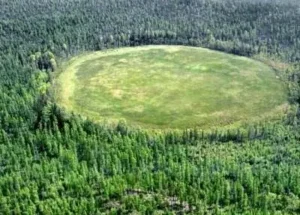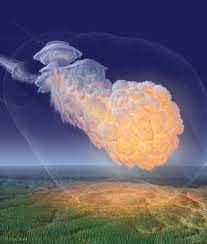In the early morning of June 30, 1908, a remote region in Siberia was struck by a catastrophic explosion, an event known as the Tunguska Event. With a force estimated to be a thousand times greater than the atomic bomb dropped on Hiroshima, this mysterious blast flattened an estimated 80 million trees across an 830-square-mile area. Over a century later, the true cause of this cataclysmic event continues to baffle scientists and researchers. Let’s delve into the Tunguska Event and explore the various theories surrounding this enigmatic explosion.


Setting the Scene:
The Tunguska Event occurred near the Stony Tunguska River in the Siberian taiga. Eyewitnesses describe a bright, blueish light streaking across the sky, followed by a tremendous explosion that lit up the entire horizon. The shockwave generated by the explosion was felt hundreds of miles away and caused seismic activity similar to that of a small earthquake.
Theories and Explanations:
Numerous hypotheses have emerged over the years, attempting to explain the Tunguska Event. Although no definitive answer has been found, two main theories have gained the most traction among scientists:
1. Comet Impact Hypothesis:
The leading theory proposes that a comet, specifically a type known as a stony or icy comet, was responsible for the Tunguska Event. Composed of a mixture of ice, dust, and rocky materials, comets orbit the Sun and occasionally collide with celestial bodies, including our planet. When a comet enters the Earth’s atmosphere, it experiences intense friction and begins to disintegrate, resulting in a powerful explosion.
According to the comet impact hypothesis, the Tunguska explosion occurred when a comet approximately 200 to 600 feet in diameter entered the Earth’s atmosphere. The immense heat generated by atmospheric entry caused the comet to vaporize, resulting in the release of an enormous amount of energy. This sudden release of energy unleashed a shockwave that felled trees and caused widespread destruction.
2. Meteoroid Airburst Hypothesis:
Another prominent theory suggests that the Tunguska Event was caused by a meteoroid, a smaller celestial body compared to comets. Unlike comets, meteoroids are primarily composed of rock and metal and often come from the asteroid belt located between Mars and Jupiter.
The meteoroid airburst hypothesis postulates that a meteoroid measuring around 160-330 feet in diameter entered the Earth’s atmosphere above Tunguska. As the meteoroid traveled through the atmosphere, it rapidly decelerated due to air resistance, causing it to heat up and ignite. This sudden ignition resulted in a powerful airburst explosion above the ground, triggering the devastating shockwave and flattening the surrounding forest.
Conclusion:
Despite numerous scientific investigations, the exact cause of the Tunguska Event remains unknown. While the comet impact hypothesis and the meteoroid airburst hypothesis have provided plausible explanations, the lack of definitive evidence hampers our complete understanding of this mysterious explosion.
Nonetheless, the Tunguska Event continues to captivate researchers worldwide, and various expeditions have sought to uncover more evidence. The study of this enigmatic event not only deepens our understanding of the Earth’s history but also highlights the potential dangers associated with celestial bodies that intersect with our planet.
The Tunguska Event reminds us of the vastness and mysteries that lie beyond our planet, constantly urging scientists to explore and uncover the secrets of our universe.

